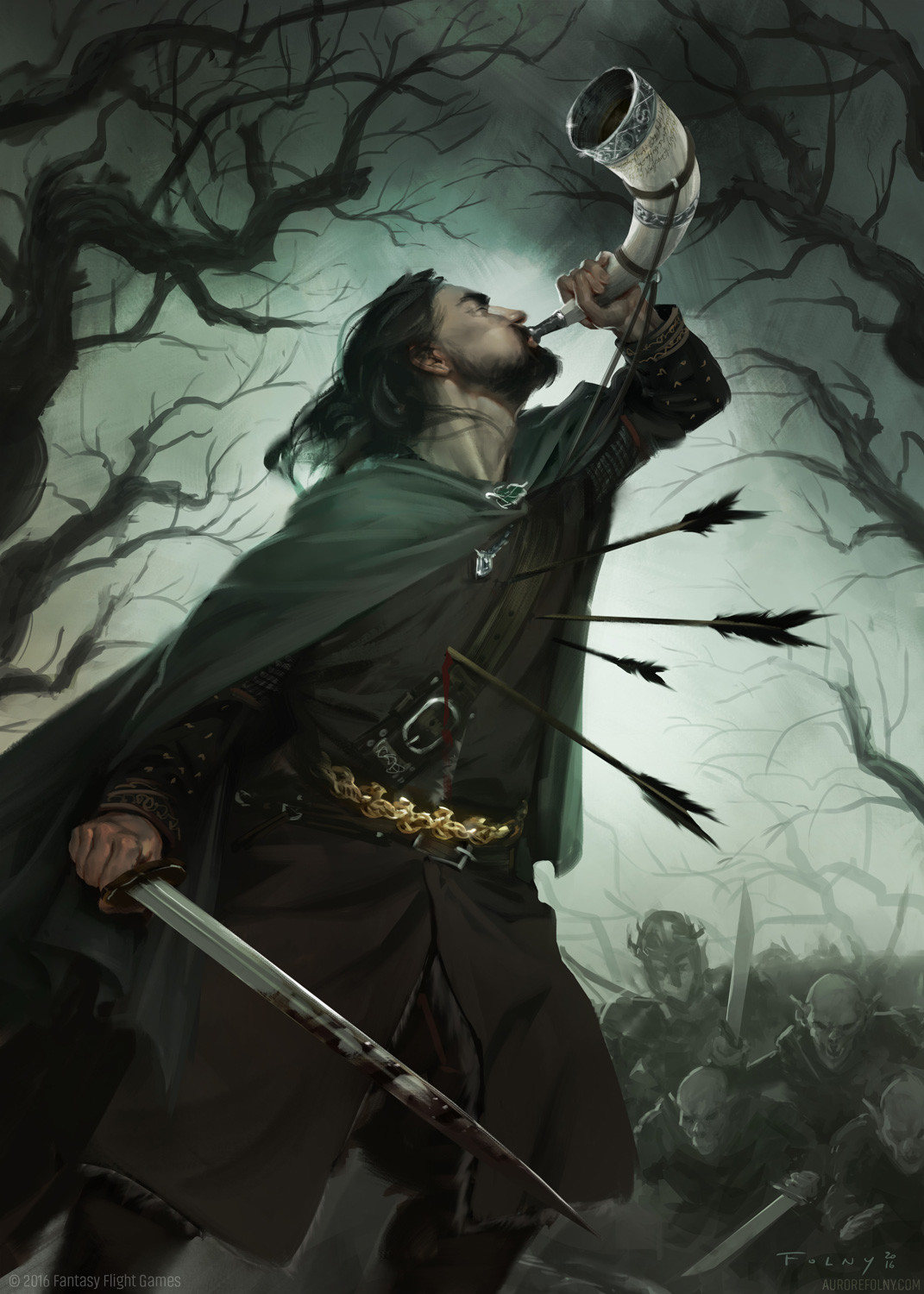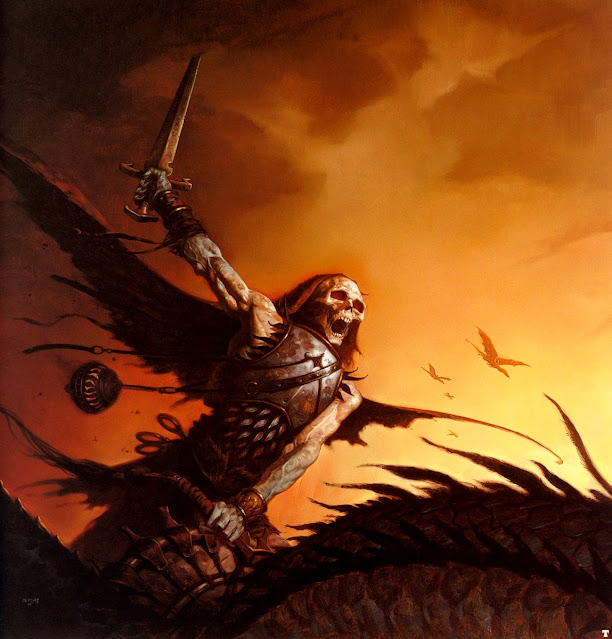 |
| Yeah, it whips ass |
Whitehack is probably my favorite of the new old school and 2e was the edition that drew me in. To put it simply, it was an evocative and surprisingly dense book. Some things I particularly liked:
- It's a ~60 page book with a complete and flexible game system, example setting, example adventures, GM advice, and suggested house rules.
- It's terse as hell but with plenty of room for interpretation. Fitting all that into this format (Christian has mentioned what a nightmare it was) means that lots of text pulls double duty, giving examples and concrete rulings at the same time. While later editions may have cleared up some things for folks, I'm an OD&D guy so I rather enjoy taking a book that's open to interpretation and making it my own.
- For example, the magic items here basically layout the rules you could use for robots, modern or futuristic firearms, and more while also being neat fantasy items.
- The sample setting is cool, but really shines best imo as a template for your own. It's easy as hell to cook up a setting and model it in a similar presentation. I have several on this blog.
- No art, no muss, no fuss. There's something about a simple booklet of text that is appealing to me. In my opinion it makes it all the easier to swap set dressings and not assume any tone or style to the worlds I play in.
I've played and enjoyed 2e, 3e, and 4e for many years now but the loss of the sample The White Curse setting in the jump to 3e did sadden me. So I wanted to share some of the interesting areas where this setting and its adventures did "double duty" in my opinion and present them here as simple setting-agnostic rule commentary for use in your own Whitehack games!
Defining Your Settings Groups
When you go to setup your Whitehack setting (either your own or adapting an existing one), groups are a powerful tool. They make a nice "menu" of items for your players to pick from and lets everyone get an immediate idea of the factions at play.
For species groups, simply list out the options the players have available for the setting or potentially hint at any rare species-as-class options that might come into play later.
Affiliation groups are where you can really get into laying out the setting . Consider categories such as "Economic Groups", "Political Groups", "Religious Groups", and a then an "Other" for anything else. If there's lots of overlap, such as a setting where religious groups hold political power, you can merge these categories. For each category, list out ~6 or so evocative faction names. ~18 to ~30 group names gives the players a lot of things to potentially find interesting and latch onto.
You don't need to flesh out all the details for each at this point, but you should be able to answer general questions during character creation or be ready to flip the question to the player if they are up for it, e.g. "How rough was my initiation into the Cult of the Redeemed?" "You tell me!" In call cases, let any willing players give you suggestions.
Draining Attributes
Some enemies, magics, or items might drain or damage attributes rather than merely reducing hit points. When an attribute is reduced to 0, the character suffers some horrible fate. Drained attributes heal in the same manner as hit points and may require.
The allip is the spectral remains of one driven to destruction by their own madness. It's touch rends the sense of self, draining 1d6-2 wisdom with each successful attack. At 0 wisdom, a character becomes catatonic in a mindless slumber.
Sample NPCs
Whitehack has several examples of monsters and NPCs already, but I've extrapolated some interesting trends for more general NPCs from the samples in The White Curse.
- Common townsfolk have but 1 HP. Dedicated soldiers or hardy militia have 2 Hit Dice. Along with the understanding that hirelings are usually 1 HD, this gives us a comfortable range of 1 HP to 2 HD for most mundane humans. Here's a basic stat block:
- Basic Human: HD <1, MV 30, AC 0, No special abilities of note.
- Exceptional NPCs could be anything from 4 HD or even higher.
- NPCs can have class abilities as a shorthand. This allows them to emulate the PC classes without necessarily being created like a PC.
- Guilder Thief: HD 1, AC 1, MV 30; Deft, attuned to throwing knives.
- Fire Cult Leader: HD 4, AC 0, MV 3; Wise, miracle "Control Flames".
- Sir Gord: HD 8, AC 3 (plate mail), MV 25, Strong Abilities 1, 2, and 5.
Some Classic Traps
Here are some classic traps to use as a benchmark when creating or adapting traps to Whitehack.
- Pit Traps: 2d6 damage, save negates, ~10'-15' deep.
- Falling Stone Trap: d6+2 damage, save negates.
- Poison Dart Trap: 1d6 poison on a failed save.
- Rolling Boulder Trap: 3d6 crushing damage, save negates.
How to Award Quest XP
Quest XP gets some very open guidelines in Whitehack, but we can make it more precise. When rewarding quest XP, consider the nature of the adventure and the goal being pursed by a party.
For a typical low level adventure:
- For major quest goals, everyone gets ~1,500 XP.
- For minor quest goals, everyone gets ~1,000 XP.
- The typical adventure likely has 1 major quest and can often have 1-2 minor quests.
As characters advance and undertake greater tasks, over half of their advancement XP could be from quests. We can reasonably extrapolate this. Multiply their the above amounts by their level to get a suitable amount of quest XP.
| Level | Minor | Major |
| 1 | 1,000 | 1,500 |
| 2 | 2,000 | 3,000 |
| 3 | 3,000 | 4,500 |
| 4 | 4,000 | 6,000 |
| 5 | 5,000 | 7,500 |
| 6 | 6,000 | 9,000 |
| 7 | 7,000 | 10,500 |
| 8 | 8,000 | 12,000 |
| 9 | 9,000 | 13,500 |
| 10 | 10,000 | 15,000 |
Using Auctions for a Competing Search
Auctions are a pretty neat mechanic. It could be used to model two parties searching for something in an environment. For example, consider two groups combing a marshy area for the entrance to the Lost Barrow. Depending on how the competing parties are getting around, you could base the auction on strength (for trudging through the swamp), dexterity (for those boating), or perhaps charisma (for those driving an large swamp gator). Every player should get an opportunity to bid for the whole group, discussing the bids amongst the players if needed. Role-play out the bids as well. The winning party perhaps gets their choice of potential routes and of course arrives first. The losing party gets no such choice and arrives sometime later.






